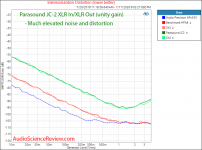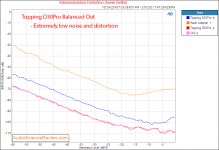Correct me if I am wrong, but I think it doesn't really matter whether you use analogue or digital filtering for the dipole effect.
With digital compensation (I think FA uses 32 bit DSP), the internal bit-depth of the 16 bit sound reamains intact until 96dB attenuation, the limiting factor is the analogue output stage of the DAC, because it have self-noise.
With active analogue compensation, the limiting factor is the output stage of the amp, because it have self-noise, which can be attenuated only by passive filtering.
But then with passive filtering, the limiting factor usually the environment, with its noise.
I think you are absolutely correct. When 16-bit source is put through 24-bit spdif interface, the extra bits go to the end of the word giving it more dynamic range=less quantization noise=noise floor is further away (this is computer math). DSP engine can add its own extra bits to start and end of the word giving it even more DR and head room for adding gain. That's what I'd do if making DSP plates was my day job...
Main problem is DAC noise and distortion and it is relatively close to 16 bit dynamic range of 96 dB, so it is important to optimize digital and analog gains to get the best result.
I made some calculations for FA DSP module and NC252MP SINAD.
AK4454 THD+N with AVDD=5V is 107 dB at for full scale signal, it mean about 17 bits, not 20 bits what is for best DAC-s.
ASR had measured for NC252MP 94 dB SINAD at 5W output, so I had on digital side about 13 dB for level adjust because dipole cancellation boost and volume control but I need about 20 dB +20 dB.
I made some calculations for FA DSP module and NC252MP SINAD.
AK4454 THD+N with AVDD=5V is 107 dB at for full scale signal, it mean about 17 bits, not 20 bits what is for best DAC-s.
ASR had measured for NC252MP 94 dB SINAD at 5W output, so I had on digital side about 13 dB for level adjust because dipole cancellation boost and volume control but I need about 20 dB +20 dB.
Conversion from 16 bit signal to 24 bit by adding extra bits to the end of sample not remove initial 16 bit signals quantization noise. You cannot know what bit values to add to get 16 bit quantization noise away.I think you are absolutely correct. When 16-bit source is put through 24-bit spdif interface, the extra bits go to the end of the word giving it more dynamic range=less quantization noise=noise floor is further away (this is computer math). DSP engine can add its own extra bits to start and end of the word giving it even more DR and head room for adding gain. That's what I'd do if making DSP plates was my day job...
Last edited:
It depends where the noise is created. Changing the DAC and/or gain will not affect the power amp's noise.
The ASR measurement is 5W into 4ohms, therefore +4dB compared to 2.8V standard sensitivity level. Subtract that, giving -90dB, then add your driver's sensitivity to see what SPL the amp's noise will be.
Best scenario:
The ASR measurement is 5W into 4ohms, therefore +4dB compared to 2.8V standard sensitivity level. Subtract that, giving -90dB, then add your driver's sensitivity to see what SPL the amp's noise will be.
Best scenario:
- amp hiss is inaudible (of course)
- DAC's max output almost clips amp (minimizing noise from DAC)
- amp clips slightly above max SPL you'd ever use (maximizing overall DR)
Conversion from 16 bit signal to 24 bit by adding extra bits to the end of sample not remove initial 16 bit signals quantization noise. You cannot know what bit values to add to get 16 bit quantization noise away.
Misassumption there my friend. The value of one word is between -1.0 and 1.0. Adding more bits adds more decimals, so that gives higher precision which translates to higher dynamic range.
1111 1111 1111 1111 <-- 16 bits...
1111 1111 1111 1111 0000 0000 <-- converted to 24-bits...
0000 0111 1111 1111 1111 1000 <-- and attenuated by 30 dB. Still not loosing any bits.
One more aspect. What is more audible, digital signal quantization noise or amplifier SINAD?
You don't hear quantization noise with the FA, because the processing is 32 bit.
I didn't heard quantization noise yet at any level (from whisper quiet to insane loud) and I using a 109dB/2.83V sensitive compression driver which requires a lot of attenuation, funny that it's about 20dB attenuation in the pass-band at some frequencies and to my ears the digital attenuation still sounds better (despite the higher noise floor) than a passive L-pad attenuation. The higher noise is only detectable when no music or sound coming from the speakers at least 30 sec and the room is quiet.
Read once more what I wrote: "this will not remove initial 16 bit signals quantization noise". It was not abut attenuation.Misassumption there my friend. The value of one word is between -1.0 and 1.0. Adding more bits adds more decimals, so that gives higher precision which translates to higher dynamic range.
1111 1111 1111 1111 <-- 16 bits...
1111 1111 1111 1111 0000 0000 <-- converted to 24-bits...
0000 0111 1111 1111 1111 1000 <-- and attenuated by 30 dB. Still not loosing any bits.
You don't hear quantization noise with the FA, because the processing is 32 bit.
Question is about initial 16 bit signal quantization noise.
Last edited:
I made more detailed calculation.
My speakers has 93 dB/W/m sensitivity in mid range, and this is also about my comfort level for listening, may be little lower. All ranges are 8 om speakers.
With bass dipole compensation about 20 dB I will have in bass range at 20 Hz power 100W, this is very close to NC252MP maximum power. To get this power I need 1,5V input voltage if NC252MP had regular gain 25,5dB. This is about 3 db lower than Hypex DSP DAC full level output 2.2V.
For getting 1 W output on mid range and tweeter amps I can use lower gain on MC252MF, what is 12 dB without buffer. For that is needed input 0.71 V what is 9.8 dB lower than Hypex DSP DAC full level output 2.2V. This level will bring DAC output SINAD comparing to 0,71 V level to same -96 dB what noise had 16 Bit signal.
For me this seems maximum what is possible in meaning of signal SINAD and noises on DAC outputs.
At 1W output level NC252MP SINAD is about 90 dB, what is also not bad.
Only I did not know what is NC252MP SINAD without input buffer or what is NC100HF SINAD without buffer.
On datasheet NC100HF SNR is 106 dB, NC252MP SNR is 121 dB. NC252MP output is about 2 dB higher so probably then NC100HF SINAD at 1 W can be 121-2-106= 13 dB lower than NC252MP, what is then 77 dB.
Is this correct, or I had made mistake somewhere?
My speakers has 93 dB/W/m sensitivity in mid range, and this is also about my comfort level for listening, may be little lower. All ranges are 8 om speakers.
With bass dipole compensation about 20 dB I will have in bass range at 20 Hz power 100W, this is very close to NC252MP maximum power. To get this power I need 1,5V input voltage if NC252MP had regular gain 25,5dB. This is about 3 db lower than Hypex DSP DAC full level output 2.2V.
For getting 1 W output on mid range and tweeter amps I can use lower gain on MC252MF, what is 12 dB without buffer. For that is needed input 0.71 V what is 9.8 dB lower than Hypex DSP DAC full level output 2.2V. This level will bring DAC output SINAD comparing to 0,71 V level to same -96 dB what noise had 16 Bit signal.
For me this seems maximum what is possible in meaning of signal SINAD and noises on DAC outputs.
At 1W output level NC252MP SINAD is about 90 dB, what is also not bad.
Only I did not know what is NC252MP SINAD without input buffer or what is NC100HF SINAD without buffer.
On datasheet NC100HF SNR is 106 dB, NC252MP SNR is 121 dB. NC252MP output is about 2 dB higher so probably then NC100HF SINAD at 1 W can be 121-2-106= 13 dB lower than NC252MP, what is then 77 dB.
Is this correct, or I had made mistake somewhere?
Question is about initial 16 bit signal quantization noise.
How can you listen to music at all if you are so concerned about quantization noise of the CD quality?
Joopajoo,
Luckily I'm not as talented mathematically as kaamelis! I mix analog and digital sources deliberately, do several chained conversions until "signal" reaches classD amps. Still I can enjoy music played low or high spl, no hiss or clipping. I feel sad only because of too much compression in pop and even some jazz recordings.
Luckily I'm not as talented mathematically as kaamelis! I mix analog and digital sources deliberately, do several chained conversions until "signal" reaches classD amps. Still I can enjoy music played low or high spl, no hiss or clipping. I feel sad only because of too much compression in pop and even some jazz recordings.
- Home
- Amplifiers
- Class D
- The New Hypex Fusion Plate amps

